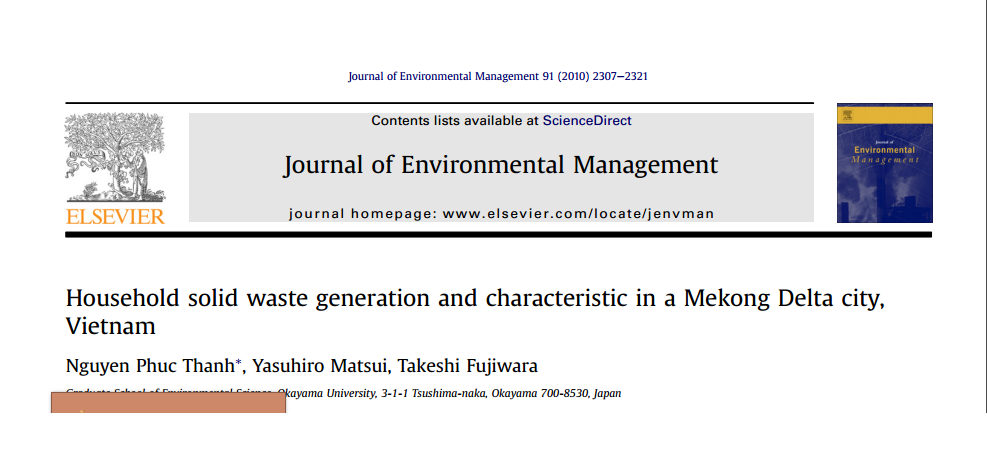REPORTS & PUBLICATION
REPORTS
PPP-ISWM Initiative in Bhutan
2010 | UNDP
Urbanization in Bhutan has taken place at a rapid pace over the last 10 years or so. By 2005, the proportion of Bhutanese urban population had grown to 31 percent. It is projected that by 2020 half of the Bhutanese population will be living in urban areas. Burgeoning urban population has created several environmental problems such as air and water pollution, water shortage, increase of municipal waste volumes and types, congestion of traffic and buildings, and land degradation. The Thimphu Municipality has not yet developed any standard and effective strategy for waste management at the household and community levels.

Household solid waste generation and composition in different family size and socio-economic groups: A case study
2010 | Elsevier
The household waste (HW) constitutes an important fraction in municipal solid waste (MSW). The composition of HW is an important factor in design an effective solid waste management plan for city. The aim of study was to estimate the quantity and quality of HW in terms of socio-economic groups and family size in the Dehradun city, India. A total of 144 households were selected from 11 major blocks of the city and HW quantification and characterization was analyzed for different blocks/colonies.
Household solid waste generation and characteristic in a Mekong Delta city, Vietnam
2010 | Elsevier
This study was undertaken to evaluate the quantity and composition of household solid waste to identify opportunities for waste recycling in Can Tho city, the capital city of the Mekong Delta region in southern Vietnam. Two-stage survey of 100 households was conducted for dry season and rainy season in 2009. Household solid waste was collected from each household and classified into 10 physical categories and 83 subcategories. The average household solid waste generation rate was 285.28 g per capita per day.
Promoting People Participation in Solid Waste Management in Myanmar
2010 | Research Journal of Environmental Sciences, 4: 209-222
The purpose of this study was to explore implementation strategies for fostering people participation in solid waste management in Myanmar. To achieve this, an action research employing mixed methods was conducted in Bagan City, within the twenty months period. Household attitudes and behavior was collected through questionnaire surveys. In-depth interview, group discussion, organizational and community meetings and observation were conducted to address problem situations, explore strategies to fix the problems and assess the outcomes.

Waste Quantification and Characterization, Madhyapur Thimi Municipality (2009)
2009 | UNEP
Madhyapur Thimi Municipality (MTM) is one of the highest urbanizing towns. It is located in the district of Bhaktapur in Bagmati Zone, Central Development Region of Nepal. Madhyapur Thimi got its municipality status only in 1996 (B.S. 2053). Five Village Development Committees namely Bode, Chapacho, Balkumari, Dibyaswori and Nagadesh prior to this declaration were amalgamated to form this municipality.

Converting Waste agriCulturalBiomass into a resource : Compendium of Technologiescbil
2009 | unep
Globally, 140 billion metric tons of biomass1 is generated every year from agriculture. This volume of biomass can be converted to an enormous amount of energy and raw materials. Equivalent to approximately 50 billion tons of oil2, agricultural biomass waste converted to energy can substantially displace fossil fuel, reduce emissions of greenhouse gases and provide renewable energy to some 1.6 billion people in developing countries, which still lack access to electricity3. As raw materials, biomass wastes have attractive potentials for large-scale industries and community-level enterprises. Biomass takes the form of residual stalks, straw, leaves, roots, husk, nut or seed shells, waste wood and animal husbandry waste. Widely available, renewable, and virtually free, waste biomass is an important resource. With the global campaign to combat climate change, countries are now looking for alternative sources of energy to minimize green house gas (GHG) emissions. Aside from being carbon neutral, the use of biomass for energy reduces dependency on the consumption of fossil fuel; hence, contributing to energy security and climate change mitigation.
 The kNOwWaste Knowledge Platform was developed through a Project Cooperation Agreement funding by UNEP on 2016. The platform provides data and information on holistic waste management to stakeholders in Asia and the Pacific region. The platform was developed with the following aims: generate and consolidate data or information on holistic waste management, transform data into easily comprehensible outputs for use by key stakeholders, map out and disseminate information on international waste management projects under the GPWM and UNEP projects as well as other international partners, and provide capacity building support through dissemination of data or information support for relevant stakeholders on holistic waste and waste management system.
The kNOwWaste Knowledge Platform was developed through a Project Cooperation Agreement funding by UNEP on 2016. The platform provides data and information on holistic waste management to stakeholders in Asia and the Pacific region. The platform was developed with the following aims: generate and consolidate data or information on holistic waste management, transform data into easily comprehensible outputs for use by key stakeholders, map out and disseminate information on international waste management projects under the GPWM and UNEP projects as well as other international partners, and provide capacity building support through dissemination of data or information support for relevant stakeholders on holistic waste and waste management system.
 2024 © Regional Resource Center for Asia and the Pacific (RRC.AP). All Rights Reserved.
2024 © Regional Resource Center for Asia and the Pacific (RRC.AP). All Rights Reserved.
